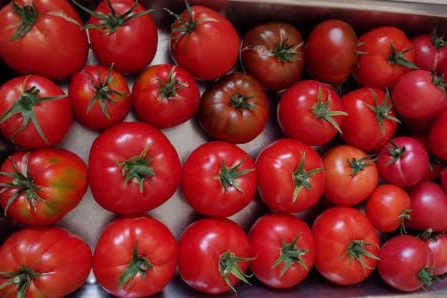Already the end of August and by 8 p.m., it is getting dark. It makes for a very short day when the temperature is in the 30s and it is too hot to work in the garden in the afternoon.
At the beginning of September I start cutting the top of my tomato plants removing the flowers. This way I won't end up with lots of small green tomatoes and the plants will put their energy in ripening what is already on the vines. This year I didn’t have any hornworms in my plants but I found one on the ground, away from any tomato plants. Must have been lost.
This is the information I got from the farmer's almanac website. Sphinx moths, also colloquially known as hawk moths, with many of their caterpillars known as hornworms.
“In late spring, large adult moths lay eggs on the undersides of foliage, which will hatch within a week. Caterpillar larvae will feed from four to six weeks before creating a cocoon for overwintering in the soil. If the weather is warm enough, larvae may only burrow for as little as two to three weeks. Moths will emerge in the spring, and will then lay eggs once again. More than one generation a year may be possible in warmer climates.”
So far I have been keeping watch on the plants and they are doing fine.
It was the best year for my tomatoes. Lots of big ones and only a couple of them with a bit of black rot on the bottom.
My blackberry plants were loaded with fruits but the intense heat dried some and bleached many of them even with lots of watering. It did the same thing with some of the raspberries but it was the end of the harvest so it didn’t matter much.
All the fruits and berries made up this year for the last bad couple years. They looked like they were on steroids.
At this time you still can plant seeds for harvesting before the frost. You have to keep the area moist if you want the seeds to germinate.
You can plant them deeper than in the spring. If you plant in full sun, you will have to give some shade for the new plants.
You might want to start some seeds in the house and then transplant the seedlings in the garden. You should mulch the young plants to keep the roots cool.
As I was harvesting the lettuce seeds, I shook the plant over a partly empty bed and I might get some lettuce to grow. With this heat I have to water morning and night.
Some of the plants that thrive in the cooler temperature are lettuce, spinach, arugula, beets, Swiss chard, kale and a lots of Asian greens.
The summer planted crops need longer to mature because the days are getting shorter so the growth is slowed by a low-light factor.
On the average, you have to add about two weeks more than planting in the spring. My arugula has reseeded itself and is growing nicely.
When the cold weather gets here and it will one day, you have to cover the plants with some row cover or you can use a cold frame.
I was late planting my carrots but they are in the cold frame so I will have to close the lid on frosty days.
If you have not transplanted your irises, you still have time to do it now. They should be divided and transplanted every three to five years.
September is the time to transplant peonies.
For more information: 250-558-4556 jocelynesewell@gmail.com

